Portuguese Man o’ War Profile
It’s been a while since anyone was at risk from a 16th-century European warship, but this animal carries the same dangerous reputation as its namesake.
The Portuguese Man o’ War is a blue bottle with a killer sting.
It’s a marine organism called a siphonophorae that resemble a jellyfish, and drifts on the surface of the Atlantic and Indian oceans, in tropical and subtropical waters.

Portuguese Man o’ War Facts Overview
| Habitat: | Open ocean |
| Location: | Pacific, Atlantic, Indian oceans |
| Lifespan: | Unknown |
| Size: | Up to 30 m (98 ft) long tentacles, float up to 30 cm (1 ft) |
| Weight: | 1 lbs (0.5 kg) |
| Color: | Blue, sometimes purple/pink |
| Diet: | Fish |
| Predators: | Turtles, some birds, sea slugs |
| Top Speed: | Slow |
| No. of Species: |
1 |
| Conservation Status: |
Not listed |
Siphonophores are a relatively understudied group of floating ocean organisms that live somewhere between water and air.
Man-of-War colonies travel the warm currents of most of the world’s oceans in groups of up to 1,000. The top of them is around a foot in size and they have a translucent blue and purple coloring, which helps provide camouflage to the creature in the blue ocean waves.
These so called ‘jellyfish’ are actually several very specialised animals stuck together. They’re so dependent on one another that some have to chew, and others do the pooping.
One giant inflatable one sits on top and carries them all around in the wind, and plenty of extremely long rows of them reach deep into the ocean to paralyse and catch fish to eat.
They are carnivores and use these long tentacles with nematocysts full of venom to paralyze prey, before reeling them. They mainly diet on fish, plankton, worms, and squid.
As strange as they are, they’re still food for a bunch of animals, including some that use the stinging cells of the tentacles as its own weapon. They also quite frequently end up washed ashore!
Interesting Portuguese Man o’ War Facts
1. It’s named after a dangerous ship
Between the 16th and 19th centuries, when humanity spent the most time blowing each other up in the ocean, a sufficiently big and powerful sail ship was known as a man-of-war, or man o’ war.
The inflated float of the animal resembles the Portuguese version of this warship and was therefore named after it.
In other dialects, it’s known as a blue bottle (for obvious reasons).
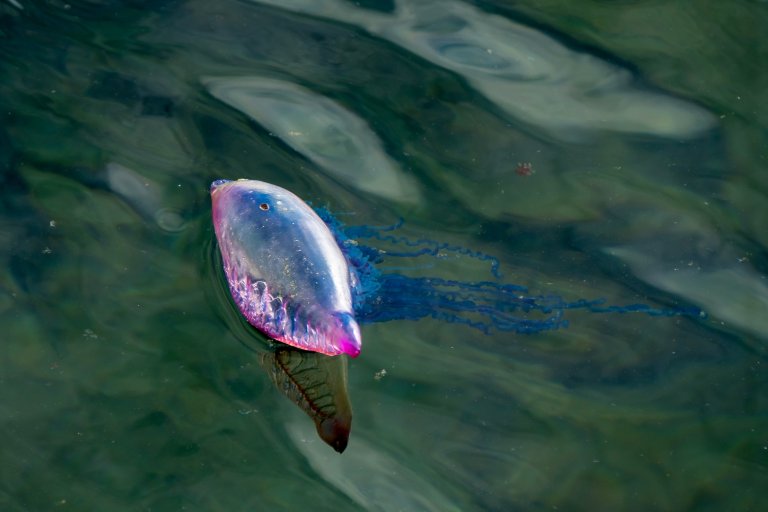
2. It’s not a single creature
If you look at an ant colony for long enough, you start to see an organism that isn’t bound by physical tissues. The colony itself seems to have a hive mind, and the individuals that comprise it are merely tools or body parts that serve a higher function than their own individual needs.
This is, partially, true. And many colony animals will gladly sacrifice their lives for the colony or die if forced to exist independently of it.
At the other end of the spectrum, there are organelles like mitochondria and chloroplasts that exist inside cells and may have evolved from third-party organisms but wouldn’t be considered individual life forms now.
Man o’ war jellyfish are not actually jellyfish at all and sit somewhere between these two examples. Their bodies are formed of four individual organisms that form a fixed colony, combining tiny little specialised animals into a greater organism called a siphonophore.
Each organism is a clone of the one next to it, but can take various shapes and sizes to fulfil its role, depending on where on the organism it’s needed. These four co-dependent polyps include:
- The gas-filled polyp (the ‘pneumatophore’) or bladder, that acts as a floatation device and sail.
- The tentacle-bearing zooids that can defend and catch prey (dactylozooids).
- The polyp that digests food (gastrozooid).
- The polyp that helps reproduce (gonozooid).
So, in terms of ecology, it’s an organism, and it does individual organism stuff like changing places and eating.
But from a biological or physiological perspective, it’s a colony of animals. 1
3. Their float is filled with gases
The single polyp or bladder than can be up to 12 inches long sits above the waters surface like a sail.
It’s filled with gases, such as carbon monoxide, oxygen, and argon.
This is what helps keeps the siphonophore afloat.

4. Colony sex
Unlike ant colonies, the Man o’ war colonies are sexually binary, being either male or female – consisting either all-female polyps or all-male polyps.
This means they can reproduce sexually, and they do so by producing either sperm or eggs, and releasing them into the water.
The rest is a bit of a mystery, as nobody’s seen it, but the fertilised eggs likely turn into some kind of self-cloning colony that grows into the jellyfish-like animal as it matures. 2
5. They’re almost entirely at the mercy of the wind
The man o’ war doesn’t get much say in where it goes. The large float is set up to keep the body of the animal up on the surface of the water and catch any wind that comes by.
This wind drags it along at random, and pulls its tentacles through the water, acting like a stinging net, to catch fish.
If the wind changes direction, so does the animal. Aside from a small amount of contraction of the sail, the organism doesn’t really control any locomotion for itself.
As such, they are routinely washed up on beaches during strong winds.
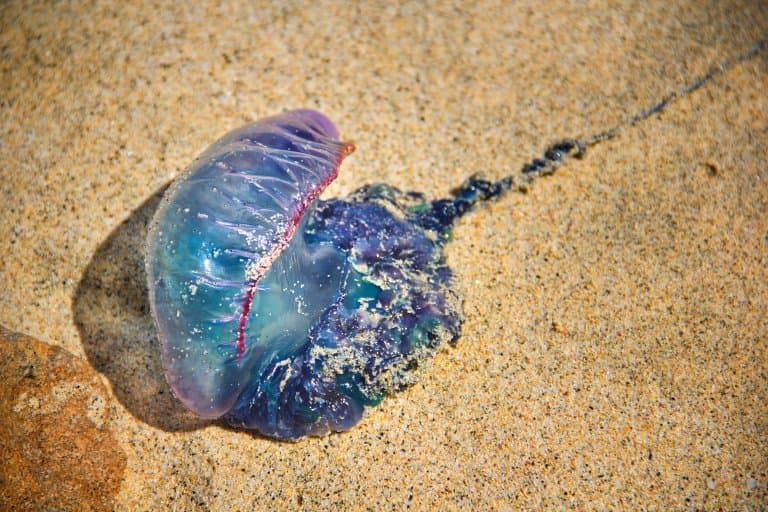
6. They come in left and right-handed
The sail itself is curved into a slight crescent, and it is widely believed that this has something to do with avoiding these beaching events.
The crescents appear in the early development of the organisms
The hypothesis goes that left-handed crescents will be less affected by certain wind directions than right-handed ones, and so during a storm, only one shape is likely to get washed up, keeping the population alive as a whole.
This doesn’t appear to be backed up by evidence, and it’s likely that both left and right-handed man o’ wars will be affected very similarly by strong winds.
7. Their tentacles can reach over 30 m (100 ft)
Being dragged around the ocean into your food is an exceptionally lazy existence, but the man o’ war is well-equipped for it.
Tentacles of up to 30 meters long dangle into the deep and snag on anything soft enough to sting. They then stick onto the prey (almost always fish) and inject a paralysing toxin into them.
These same tentacles then retract and pull the food item towards the individuals responsible for digesting it. These grotesque little mouths called gastropods, all begin to get very excited, smacking their little lips and attaching themselves to the prey.
A 10 cm fish can be engulfed by up to 50 of these monstrosities, which release digestive enzymes and begin to break down the fish before passing it into the gastric cavity for absorption.
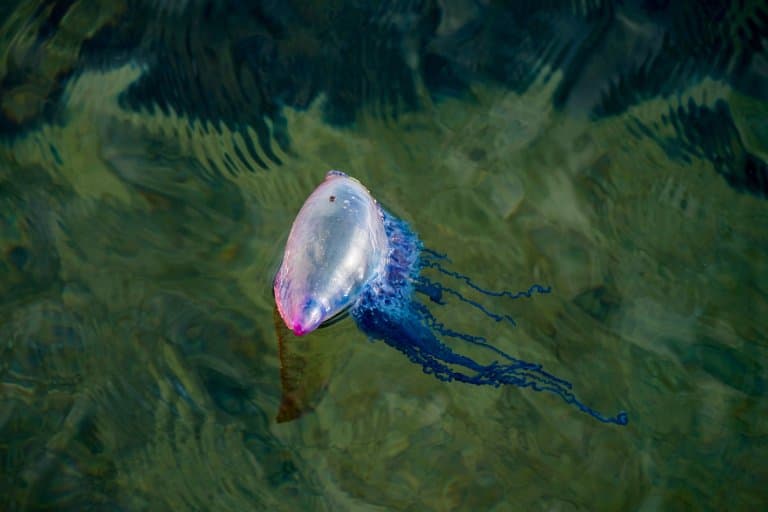
8. Nudibranchs eat them
The very venomous sea slug known as the blue sea dragon is one of the few soft-bodied predators of the man o’ war and makes great use of these stinging cells in the tentacles to use as their own venom defence.
This makes them more or less as painful and dangerous as the man o war itself and can be a very painful surprise for anyone picking them up by hand.
9. Blanket octopuses use them as weapons
It’s one thing to absorb useful toxins from your meal, it’s entirely another to rip off its tentacles and wield them like a whip. Blanket octopus do just that.
The males, being smaller and more vulnerable than the enormous females, will use their immunity to the man o’ war’s stings to their advantage, fending off threats with a toxic, stinging whip. 3
10. They are responsible for 10,000 strings each year in Australia
Their tentacles have nematocysts that trigger and inject venom on contact and can cause severe pain for humans. Because of this painful sting, the Man-o-War is also known as the ‘floating terror’.
The pain usually subsides after an hour, but it can cause more severe reactions, such as shock, fever, swelling resulting in airway blockage and cardiac issues.
While extremely rare, the sting can result in death if stung by a large number of tentacles, or the victim is vulnerable, such as young, or elderly.
The most effective treatment for stings is vinegar and a hot pack on the area, which can leave raised red patches on the skin, to more severe long, thin open wounds like those caused by a whip.
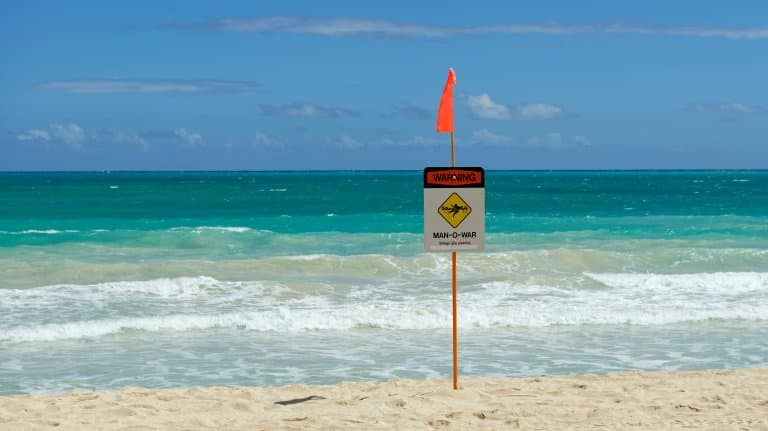
11. They can close beaches
As they are at the mercy of winds, they can be blown onto beaches. They drift in colonies, so often finding one Portuguese man o’ war can result in finding more in the area.
On occassions there are mass beach strandings of the the Portuguese man o’ war.
Their tentacles can still sting when they are beached, including for days after they have died, or if their tentacles have become detached.
As a result, beaches can often be closed for safety reasons.
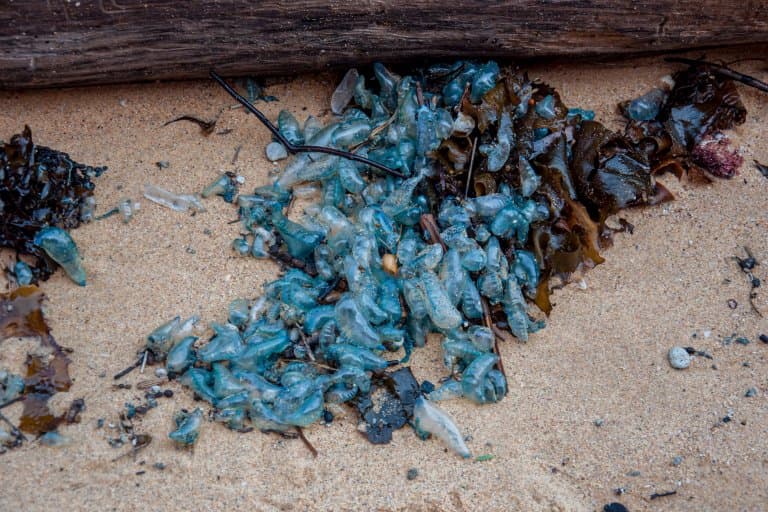
Portuguese Man o’ War Fact-File Summary
Scientific Classification
| Kingdom: | Animalia |
| Phylum: | Cnidaria |
| Class: | Hydrozoa |
| Order: | Siphonophorae |
| Family: | Physaliidae |
| Genus: | Physalia |
| Species Name: |
Physalia Physalis |
Fact Sources & References
- Dr. Rachael King, “The Portuguese man-of-war (Physalia physalis)“, South Carolina Department of Natural Resources.
- Catriona Munro et al. (2019), “Morphology and development of the Portuguese man of war, Physalia physalis“, Nature.com.
- Matt Simon (2015), “Absurd Creature of the Week: The Octopus That’s Pretty Much Just a Swimming Blanket“, Wired.com.
